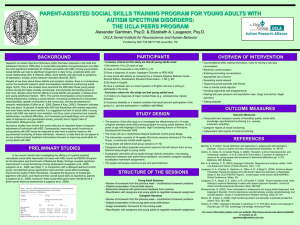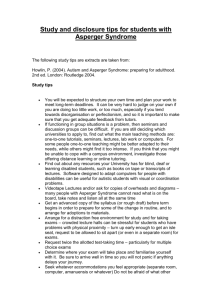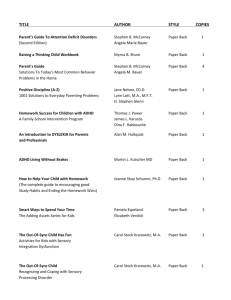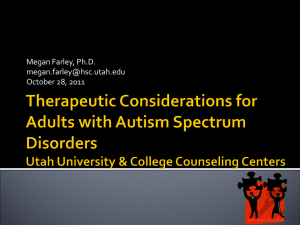Diagnosing Aspergers
advertisement
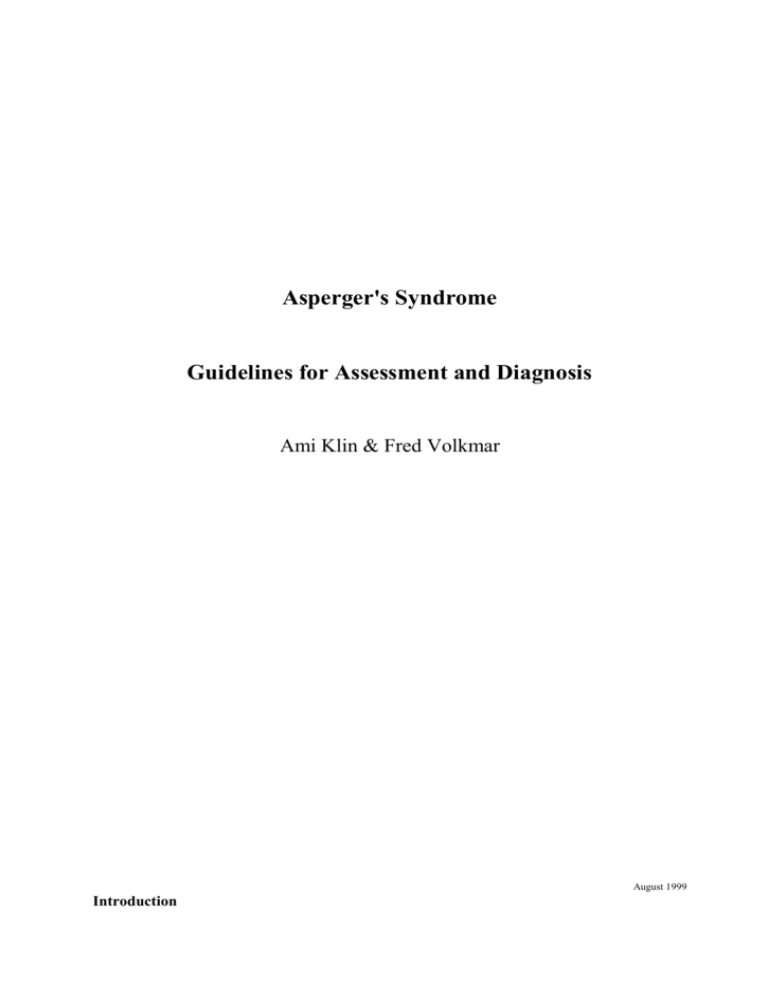
Asperger's Syndrome Guidelines for Assessment and Diagnosis Ami Klin & Fred Volkmar August 1999 Introduction Asperger Syndrome (AS) is a severe developmental disorder characterised by major difficulties in social interaction, and restricted and unusual patterns of interest and behaviour. There are many similarities with autism without mental retardation (or "Higher Functioning Autism"), and the issue of whether Asperger syndrome and Higher Functioning Autism are different conditions is not resolved. To some extent, the answer to this question depends on the way clinicians and researcher make use of this diagnostic concept, since until recently there was no "official" definition of Asperger syndrome. The lack of a consensual definition led to a great deal of confusion as researchers could not interpret other researchers' findings, clinicians felt free to use the label based on their own interpretations or misinterpretations of what Asperger syndrome "really" meant, and parents were often faced with a diagnosis that nobody appeared to understand very well, and worse still, nobody appeared to know what to do about it. School districts ere not aware of the condition, insurance carriers could not reimburse services provided on the basis of this "unofficial" diagnosis, and there was no published information providing parents and clinicians alike with guidelines on the meaning and implications of Asperger syndrome, including what should the diagnostic evaluation consist of and what forms of treatment and interventions were warranted. This situation has changed somewhat since Asperger syndrome was made "official" in DSM-IV (APA, 1994), following a large international field trial involving over a thousand children and adolescents with autism and related disorders (Volkmar et al., 1994). The field trials revealed some evidence justifying the inclusion of Asperger syndrome as a diagnostic category different from autism, under the overarching class of Pervasive Developmental Disorders. More importantly, it established a consensual definition for the disorder which should serve as the frame of reference for all those using the diagnosis. However, the problems are far from over. Despite some new research leads, knowledge on Asperger syndrome is still very limited. For example, we don't really know how common it is, or the male/female ratio, or to what extent there may be genetic links increasing the likelihood of finding similar conditions in family members. Clearly, the work on Asperger syndrome, in regard to scientific research as well as in regard to service provision, is only beginning. Parents are urged to use a great deal of caution and to adopt a critical approach toward information given to them. Ultimately, the diagnostic label any label, does not summarise a person, and there is a need to consider the individual's strengths and weaknesses, and to provide individualised intervention that will meet those (adequately assessed and monitored) needs. That notwithstanding, we are left with the question of what is the nature of this puzzling social learning disability, how many people does it affect, and what can we do to help those affected by it. The following guidelines summarise some of the information currently available on those questions. Background Autism is the most widely recognised pervasive developmental disorder (PDD). Other diagnostic concepts with features somewhat similar to autism have been less intensively studied, and their validity, apart from autism, is more controversial. One of these conditions, termed Asperger syndrome (AS) was originally described by Hans Asperger (1944, see Firth’s translation, 1991), who provided an account of a number of cases whose clinical features resembled Kaneka’s (1943) description of autism (e.g.. problems with social interaction and communication, and circumscribed and idiosyncratic patterns of interest). However, Asperger's 2 description differed from Kanner's in that speech was less commonly delayed, motor deficits were more common, the onset appeared to be somewhat later, and all the initial cases occurred only in boys. Asperger also suggested that similar problems could be observed in family members, particularly fathers. This syndrome was essentially unknown in the English literature for many years. An influential review and series of case reports by Lorna Wing (1981) increased interest in the condition, and since then both the usage of the term in clinical practice and number of case reports and research studies have been steadily increasing. The commonly described clinical features of the syndrome include (a) paucity of empathy; (b) nave, inappropriate, one-sided social interaction, little ability to form friendships and consequent social isolation; (c) pedantic and monotonic speech; (d) poor non-verbal communication; (e) intense absorption in circumscribed topics such as the weather, facts about TV stations, railway tables or maps, which are learned in rote fashion and reflect poor understanding, conveying the impression of eccentricity; and (f) clumsy and ill- co-ordinated movements and odd posture. Although Asperger originally reported the condition only in boys, reports of girls with the syndrome have now appeared. Nevertheless, boys are significantly more likely to be affected. Although most children with the condition function in the normal range of intelligence, some have been reported to be mildly retarded. The apparent onset of the condition, or at least its recognition, is probably somewhat later than autism; this may reflect the more preserved language and cognitive abilities. It tends to be highly stable, and the higher intellectual skills observed suggest a better long-term outcome than is typically observed in autism. Related Diagnostic Concepts Several similar diagnostic concepts originating from. adult psychiatry, neuropsychology, neurology, and other disciplines share, to a great degree, the phenomenological aspects of AS. For example, Wolff and colleagues described a group of individuals with an abnormal pattern of behaviour characterised by social isolation, rigidity of thought and habits, and an unusual style of communication. This condition was named schizoid personality disorder in childhood. Unfortunately, a developmental account of this concept was not provided, making it difficult to ascertain the extent to which the individuals described may have also exhibited autistic- like symptomatology early on in life. More generally, the understanding of AS as an unchanging personality trait fails to fully appreciate the developmental aspects of the disorder which may prove to be of great importance for differential diagnosis. In neuropsychology, a great deal of research has been devoted to Rourke's (1989) concept of Nonverbal Learning Disabilities syndrome (NLD). The main contribution of this line of research has been the attempt to delineate the implications for the child's social and emotional development of a unique profile of neuropsychological assets and deficits that appears to have a deleterious impact on the person's capacity for socialisation as well as on the person's interactive and communicative styles. The neuropsychological characteristics of individuals with the NLD profile include deficits in tactile perception, psychomotor co-ordination, visualspatial organisation, non-verbal problem- solving, and appreciation of incongruities and humour. NLD individuals also exhibit well developed rote verbal capacities and verbal memory skills, difficulty in adapting to novel and complex situations, and over reliance on rote behaviours in such situations, relative deficits in mechanical arithmetic as compared to 3 proficiencies in single-word reading, poor pragmatics and prosody in speech, and significant deficits in social perception, There are marked deficits in the appreciation of subtle and even fairly obvious non-verbal aspects of communication, that often result in other person's social disdain and rejection. As a result, NLD individuals show a marked tendency toward social withdrawal and are at risk for development of serious mood disorders. Many of the clinical features clustered together in NLD have also been described in the neurological literature as a form of Developmental Learning Disability of the Right Hemisphere (Denckla, 1983; Voeller, 1986). Children presenting with this condition have also been shown to exhibit profound disturbances in interpretation and expression of affect and other basic interpersonal skills. Finally, an additional term researched in the literature, semantic-pragmatic disorder (Bishop, 1989), has also captured aspects of NLD and AS. It is currently unclear whether these concepts describe different entities or, more probably, provide different perspectives on a heterogeneous, yet overlapping, group of individuals sharing at least some common aspects. An important goal of current research is to seek a convergence between the various discipline-specific accounts in order to make use of different methodologies in the effort to validate the behaviourally defined concept of AS. However, in order to enhance comparability of studies, it is of great importance to establish consensual and stringent guidelines for the diagnosis of AS, particularly in regard to its similarities with related conditions. Categorical Definition and Clinical Description As defined in DSM- IV (the most recent Diagnostic and Statistical Manual of the American Psychiatric Association, 1994), the tentative criteria for AS follow the same format, and in fact overlap to some degree, the criteria for autism. The required symptomatology is clustered in terms of onset, social and emotional, and "restricted interests" criteria, with the addition of two common but not necessary characteristics involving motor deficits and isolated special skills, respectively. A final criterion involves the necessary exclusion of other conditions, most importantly autism or a subthreshold (or "autistic- like") form of autism (Pervasive Developmental Disorder - Not Otherwise Specified). Interestingly, the DSM-IV definition of AS is offered having autism as its point of reference; hence some of the criteria actually involve the absence of abnormalities in some areas of functioning that are affected in autism. The following table summarises the DSMIV definition of AS: DSM-IV definition of Asperger Syndrome (called "Asperger Disorder") (APA, 1994) * A. Qualitative impairment in social interaction, as manifested by at least two of the following: (1) marked impairment in the use of multiple non-verbal behaviours such as eye-toeye gaze, facial expression, body postures, and gestures to regulate social interaction (2) Failure to develop peer relationships appropriate to developmental level. (3) A lack of spontaneous seeking to share enjoyment, interests, or achievements with other people (4) Lack of social or emotional reciprocity * B. Restricted repetitive and stereotyped patterns of behaviour, interests, and activities, as 4 Manifested by at least one of the following: (1) Encompassing preoccupation with one or more stereotype and restricted patterns of interest That is abnormal either in intensity or focus (2) Apparently inflexible adherence to specific, non-functional routines or rituals (3) Stereotyped and repetitive motor mannerisms (4) Persistent preoccupation with parts of objects * C. The disturbance causes clinically significant impairment in social, occupational, or other important areas of functioning * D. There is no clinically significant general delay in language (e.g., single words used by age 2 years, communicative phrases used by age 3 years) * E. There is no clinically significant delay in cognitive development or in the development of age-appropriate self-help skills, adaptive behaviour (other than in social interaction), and curiosity about the environment in childhood * F. Criteria are not met for another specific Pervasive Developmental Disorder or Schizophrenia. Onset criteria In DSM-IV, the individual's history must show "a lack of any clinically significant general delay" in language acquisition, cognitive development and adaptive behaviour (other dm in social interaction). This contrasts with typical developmental accounts of autistic children who show marked deficits and deviance in these areas prior to the age of 3 years. Although the onset criterion is in agreement with Asperger's account, Wing (1981) noted the presence of deficits in the use of language for communication, if not in more specific language skills, in some of her case studies. It is currently uncertain whether the lack of delays in the prescribed areas is a differential factor between AS and autism or, alternatively, a simple reflection of the higher developmental level associated with the usage of the term AS. Other common descriptions of the early development of individuals with AS include a certain preciousness in learning to talk ("he talked before he could walk"), a fascination with letters and numbers -- in fact, the young child may even be able to decode words although with little or no understanding ("hyperlexia") -- and the establishment of attachment patterns to family members but inappropriate approaches to peers and other persons, rather than withdrawal or aloofness as in autism (e.g., the child may attempt to initiate contact with other children by hugging them or screaming at them and then puzzle at their responses). Again, these behaviours are not uncommonly described for higher- functioning autistic children as well, albeit much more infrequently. Qualitative Impairments in Reciprocal Social Interaction Although the social criteria for AS and autism are identical, the former condition usually involves fewer symptoms and has a generally different presentation than does the latter. Individuals with AS are often socially isolated but are not unaware of the presence of others, even though their approaches may be inappropriate and peculiar. For example, they may engage the interlocutor, usually an adult, in one-sided conversation characterised by longwinded, pedantic speech, about a favourite and often unusual and narrow topic. Also, although 5 individuals with AS are often self-described "loners", they often express a great interest in making friendships and meeting people. These wishes are invariably thwarted by their awkward approaches and insensitivity to other person's feelings, intentions, and nonliteral and implied communications (e.g., signs of boredom, haste to leave, and need for privacy). Chronically frustrated by their repeated Failures to engage others and make friendships, some of these individuals develop symptoms of depression that may require treatment, including medication. In regard to the emotional aspects of social transactions, individuals with AS may react inappropriately to, or fail to interpret the valence of, the context of the affective interaction, often conveying a sense of insensitivity, formality, or disregard to the other person's emotional expressions. That notwithstanding, they may be able to describe correctly, in a cognitive and often formalistic fashion, other people's emotions, expected intentions and social conventions, but are unable to act upon this knowledge in an intuitive and spontaneous fashion, thus losing the tempo of the interaction. Such poor intuition and lack of spontaneous adaptation are accompanied by marked reliance on formalistic rules of behaviour and rigid social conventions. This presentation is largely responsible for the impression of social naiveté and behavioural rigidity that is so forcefully conveyed by these individuals. As with the majority of the Behavioural aspects used to describe AS, at least some of these characteristics are also exhibited by individuals with higher-functioning autism, though, again, probably to a lesser extent. More typically, autistic persons are withdrawn and may seem to be unaware of, and disinterested in, other persons. Individuals with AS, on the other hand, are often keen, sometimes painfully so, to relate to others, but lack the skills to successfully engage them. Qualitative Impairments in Communication In contrast to autism, there are no symptoms in this area of functioning in the definition of AS. Although significant abnormalities of speech are not typical of AS, there are at least three aspects of these individuals' communication skills which are of clinical interest. First, though inflection and intonation may not be as rigid and monotonic as in autism, speech may be marked by poor prosody. For example, there may a constricted range of intonation patterns that is used with little regard to the communicative functioning of the utterance (assertions of fact, humorous remarks, etc.). Second, speech may often be tangential and circumstantial, conveying a sense of looseness of associations and incoherence. Even though in some cases this symptom may be an indicator of a possible thought disorder, it is often the case that the lack of coherence and reciprocity in speech is a result of the one-sided, egocentric conversational style (e.g., unrelenting monologues about the names, codes, and attributes of innumerable TV stations in the country), failure to provide the background for comments and to clearly demarcate changes in topic, and failure to suppress the vocal output accompanying internal thoughts. The third aspect typifying the communication patterns of individuals with AS concerns the marked verbosity observed, which some authors see as one of the most prominent differential features of the disorder? The child or adult may talk incessantly, usually about their favourite subject, often in complete disregard to whether the listener might be interested, engaged, or attempting to intellect a comment, or change the subject of conversation. Despite such longwinded monologues, the individual may never come to a point or conclusion. Attempts by 6 the interlocutor to elaborate on issues of content or logic, or to shift the interchange to related topics, are often unsuccessful. Despite the possibility that all of these symptoms may be accounted for in terms of significant deficits in pragmatics skills and/or lack of insight into, and awareness of, other people's expectations, the challenge remains to understand this phenomenon developmentally as strategies of social adaptation. Restrictive, repetitive, an stereotyped patterns of behaviour, interests, an activities Although in the DSM- IV definition the criteria for AS and autism are identical, requiring the presence of at least one of the symptoms in the list provided (see table above), it appears that the most commonly observed symptom in this cluster refers to an encompassing preoccupation with restricted patterns of interest. In contrast to autism, where other symptoms in this area may be very pronounced, individuals with AS are not commonly reported to exhibit them with the exception of the all- absorbing preoccupation with an unusual and circumscribed topic, about which vast amounts of factual knowledge are acquired and all too readily demonstrated at the first opportunity in social interaction. Although the actual topic may change from time to time (e.g., every year or two years), it may dominate the content of social interchange as well as the activities of individuals with AS, often immersing the whole family in the subject for long periods of time. Even though this symptom may not be easily recognised in childhood (because strong interests in dinosaurs or fashionable fictional characters are so ubiquitous among young children), it may become more salient later on as interests shift to unusual and narrow topics. This behaviour is peculiar in the sense that often times extraordinary amounts of factual information on learned about very circumscribed topics (e.g., snakes, names of stars, maps, TV guides, or railway schedules). Motor Clumsiness In addition to the required criteria specified above, an additional symptom is given as an associated feature though not a required criterion for the diagnosis of AS, namely delayed motor milestones and presence of "motor clumsiness". Individuals with AS may have a history of delayed acquisition of motor skills such as pedalling a bike, catching a ball, opening jars, climbing "monkey- bars", and so on. They are often visibly awkward, exhibiting rigid gait patterns, odd posture, poor manipulative skills, and significant deficits in visual-motor coordination. Although this presentation contrasts with the pattern of motor development in autistic children, for whom the area of motor skills is often a relative strength, it is similar in some respects to what is observed in older autistic individuals. Nevertheless, the commonality in later life may result from different underlying factors, for example, psychomotor deficits in the case of AS, and poor body image and sense of self in the case of autism. This highlights the importance of describing this symptom in developmental terms. Assessment AS, like other pervasive developmental disorders (PDDs), involves delays and deviant patterns of behaviour in multiple areas of functioning, that often require the input of professionals with different areas of expertise, particularly overall developmental functioning, neuropsychological features, and Behavioural status. Hence the clinical assessment of individuals with this disorder is most effectively conducted by an experienced interdisciplinary team. 7 A few principles should be made explicit prior to a discussion of the various areas of assessment. First, given the complexity of the condition, importance of developmental history, and common difficulties in securing adequate services for children and individuals with AS, it is very important that parents are encouraged to observe and participate in the evaluation. This guideline helps to demystify assessment procedures, avails the parents of shared observations that can then be clarified by the clinician, and fosters parental understanding of the child's condition. All of these can then help the parents evaluate the programs of intervention offered in their community. Second, evaluation findings should be translated into a single coherent view of the child: easily understood, detailed, concrete, and realistic recommendations should be provided. When writing their reports, professionals should strive to express the implications of their findings to the patient's day-to-day adaptation, learning, and vocational training. Third, the lack of awareness of many professionals and officials of the disorder, its features, and associated disabilities often necessitates direct and continuous contact on the part of the evaluators with the various professionals securing and implementing the recommended interventions. This is particularly important in the case of AS, as most of these individuals have average levels of Full Scale IQ, and are often not thought of as in need for special programming. Conversely. As AS becomes a more well-known diagnostic label, there is reason to believe that it is becoming a fashionable concept used in an often unwarranted fashion by practitioners who intend to convey only that their client is currently experiencing difficulties in social interaction and in peer relationships. The disorder is meant as a serious and debilitating developmental syndrome impairing the person's capacity for socialisation and not a transient or mild condition. Therefore, parents should be briefed about the present unsatisfactory state of knowledge about AS and the common confusions of use and abuse of the disorder currently prevailing in the mental health community. Ample opportunity should be given to clarify misconceptions and establish a consensus about the patient’s abilities and disabilities, which should not be simply assumed under the use of the diagnostic label. In the majority of cases, a comprehensive assessment will involve the following components: history, psychological assessment, communication and psychiatric assessments, further consultation if needed, parental conferences, and recommendations. History A careful history should be obtained, including information related to pregnancy and neonatal period, early development and characteristics of development, and medical and family history. A review of previous records including previous evaluations should be performed and the information incorporated and results compared in order to obtain a sense of course of development. Additionally, several other specific areas should be directly examined because of their importance in the diagnosis of AS. These include a careful history of onset/recognition of the problems, development of motor skills, language patterns, and areas of special interest (e.g., favourite occupations, unusual skills, and collections). Particular emphasis should be placed on social development, including past and present problems in social interaction, patterns of attachment of family members, development of friendships, self- concept, emotional development, and mood presentation. 8 Psychological Assessment This component aims at establishing the overall level of intellectual functioning, profiles of strengths and weaknesses, and style of learning. The specific areas to be examined and measured include neuropsychological functioning (e.g., motor and psychomotor skills, memory, executive functions, problem- solving, concept formation, visual- perceptual skills), adaptive functioning (degree of self-sufficiency in real-life situations), academic achievement (performance in school-like subjects), and personality assessment (e.g., common preoccupations, compensatory strategies of adaptation, mood presentation). The neuropsychological assessment of individuals with AS involves certain procedures of specific interest to this population. Whether or not a Verbal-Performance IQ discrepancy is obtained in intelligence testing, it is advisable to conduct a fairly comprehensive neuropsychological assessment including measures of motor skills (co-ordination of the large muscles as well as manipulative skills and visual- motor co-ordination, visual- perceptual skills) gestalt perception, spatial orientation, parts- whole relationships, visual memory, facial recognition, concept formation (both verbal and non-verbal), and executive functions. A recommended protocol would include the measures used in the assessment of children with Nonverbal Learning Disabilities (Rourke, 1989). Particular attention should be given to demonstrated or potential compensatory strategies: for example, individuals with significant visual-spatial deficits may translate the task or mediate their responses by means of verbal strategies or verbal guidance. Such strategies may be important for educational programming. Communication Assessment The communication assessment aims to obtain both quantitative and qualitative information regarding the various aspects of the child's communication skills. It should go beyond the testing of speech and formal language (e.g., articulation, vocabulary, sentence construction and comprehension), which are often areas of strength. The assessment should examine non-verbal forms of communication (e.g., gaze, gestures), nonliteral Language (e.g., metaphor, irony, absurdities, and humour), prosody of speech (melody, volume, stress and pitch), pragmatics (e.g., turn- taking, sensitivity to cues provided by the interlocutor, adherence to typical rules of conversation), and content, coherence, and contingency of conversation; these areas are typically one of the major difficulties for individuals with AS. Particular attention should be given to perseveration on circumscribed topics and social reciprocity. Psychiatric Examination The psychiatric examination should include observations of the child during more and less structured periods: for example, while interacting with parents and while engaged in assessment by other members of the evaluation team. Specific areas for observation and inquiry include the patient's patterns of special interest and leisure time, social and affective presentation, quality of attachment to family members, development of peer relationships and friendships, capacities for self- awareness, perspective- taking and level of insight into social and behavioural problems, typical reactions in novel situations, and ability to intuit other person's feelings and infer other person's intentions and beliefs. Problem behaviours that are likely to interfere with remedial programming should be noted (e.g., marked aggression). The patients ability to understand ambiguous nonliteral communications (particularly teasing and sarcasm) should be examined (as, often, misunderstandings of such communications may elicit 9 aggressive behaviours). Other areas of observation involve the presence of obsessions or compulsions, depression, anxiety and panic attacks, and coherence of thought. Treatment and Intervention (See also our Treatment and Intervention "Guidelines") As in autism, treatment of AS is essentially supportive and symptomatic. Special educational services are sometimes helpful, although there is, as yet, very little reported experience on the effectiveness of specific interventions. Acquisition of basic skills in social interaction as well as in other areas of adaptive functioning should be encouraged. Supportive psychotherapy focused on problems of empathy, social difficulties, and depressive symptoms may be helpful, although it is usually very difficult for individuals with AS to engage in more intensive, insightoriented psychotherapy. Associated conditions, such as depression, may be effectively treated. Despite the paucity of published information on intervention strategies and issues, a few guidelines may be offered based on informal observations made by experienced clinicians, intervention strategies used with individuals with high-functioning autism, and Rourke's (1989) suggested interventions for individuals with Nonverbal Learning Disabilities syndrome. Securing services The authorities who decide on entitlement to services are usually unaware of the extent and significance of the disabilities in AS. Proficient verbal skills, overall IQ usually within the normal range, and a solitary life style often mask outstanding deficiencies observed primarily in novel or otherwise socially demanding situations, thus decreasing the perception of the very salient needs for supportive intervention. Thus, active participation on the part of the clinician, together with parents and possibly an advocate, to forcefully pursue the patient’s eligibility for services is needed. It appears that, in the past, many individuals with AS were diagnosed as learning disabled with eccentric features, a non-psychiatric diagnostic label that is much less effective in securing services. Learning Skills, concepts, appropriate procedures, cognitive strategies, and so on, may be more effectively taught in an explicit and rote fashion using a parts-to-whole verbal instruction approach, where the verbal steps are in the correct sequence for the behaviour to be effective. Additional guidelines should be derived from the individual's neuropsychological profile of assets and deficits; specific intervention techniques should be similar to those usually employed for many subtypes of learning disabilities, with an effort to circumvent the identified difficulties by means of compensatory strategies, usually of a verbal nature. If significant motor and visual- motor deficits are corroborated during the evaluation, the individual should receive physical and occupational therapies. The latter should not only focus on traditional techniques designed to remediate motor deficits, but should also reflect an effort to integrate these activities with learning of visual-spatial concepts, visual-spatial orientation, and body awareness. Adaptive functioning 10 The acquisition of self-sufficiency skills in all areas of functioning should be a priority in any plan of intervention. The tendency of individuals with AS to rely on rigid rules and routines can be used to foster positive habits and enhance the person's quality of life and that of family members. The teaching approach should follow closely the guidelines set above (see Learning), and should be practised routinely in naturally occurring situations and across different settings in order to maximise generalisation of acquired skills. Maladaptive behaviours Specific problem-solving strategies, usually following a verbal rule, may be taught for handling the requirements of frequently occurring, troublesome situations (e.g., involving novelty, intense social demands, or frustration). Training is usually necessary for recognising situations as troublesome and for selecting the best available learned strategy to use in such situations. Social and communication skills These skills are possibly best taught by a communication specialist with an interest in pragmatics in speech. Alternatively, social training groups may be used if there are enough opportunities for individual contact with the instructor and for the practising of specific skills. Teaching may include the following: (a) appropriate non-verbal behaviour (e.g., the use of gaze for social interaction, monitoring and patterning of inflection of voice). This may involve imitative drills, working with a mirror, and so forth; (b) verbal decoding of non-verbal behaviours of others; (c) processing of visual information simultaneously with auditory information (in order to foster integration of competing stimuli and to facilitate the creation of the appropriate social context of the interaction); (d) social awareness, perspective- taking skills, correct interpretation of ambiguous communications (e.g., nonliteral language) should also be cultivated and practised. Vocational training Often, adults with AS may fail to meet entry requirements for jobs in their area of training (e.g., college degree) or fail to maintain a job because of their poor interview skills, social disabilities, eccentricities, or anxiety attacks. Having failed to secure skilled employment, sometimes these individuals may be helped by well-meaning friends or relatives to find a manual job. As a result of their typically very poor visual- motor skills they may once again fail, leading to devastating emotional implications. It is important, therefore, that individuals with AS are trained for and placed in jobs for which they are not neuropsychologically impaired, and in which they will enjoy a certain degree of support and shelter. It is also preferable that the job does not involve intensive social demands. Self-support As individuals with AS are usually self-described as loners despite an often intense wish to make friends and have a more active social life, there is a need to facilitate social contact within the context of an activity- oriented group (e.g., church communities, hobby clubs, and selfsupport groups). The little experience available with the latter suggests that individuals with AS enjoy the opportunity to meet others with similar problems and may develop relationships around an activity or subject of shared interest. 11 Pharmacotherapy Although little information about pharmacological interventions with individuals with AS is available, a conservative approach based on the evidence from autism should probably be adopted (McDougle, Price, and Volkmar, 1994). In general, pharmacological interventions with young children are probably best avoided. Specific medication might be indicated if AS is accompanied by debilitating depressive symptoms, severe obsessions and compulsions, or a thought disorder. It is important for parents to know that medications are prescribed for the treatment of specific symptoms, and not to treat the disorder as a whole. New developments in the field Although the current knowledge regarding the nature of AS and possible treatment interventions is still limited, there has been an impressive upsurge of research on this condition prompted by its formalisation in DSM- IV. Two books on AS, covering a variety of topics, will be available hopefully in late- 1997. Several research projects are underway, and better instruments are currently being developed to improve assessment and diagnosis of the condition. More importantly, awareness of AS is growing, and so is the general interest regarding the availability of services, appropriate educational placements and vocational training. The Learning Disabilities Association of America, in a partnership with the Yale Child Study Centre, will be disseminating this growing body of knowledge as it is developed. The importance of the participation of families affected by AS cannot be exaggerated. Families willing to participate in ongoing research projects (involving the nature of AS, as well as service provision and treatment interventions) taking place at the Yale Child Study Centre should read our project description and then complete the order form. Further copies available from: Service for Pupils with Physical, Sensory and Complex Learning Difficulties. Blackpool Education Authority Progress House Clifton Road Blackpool FY4 4US 01253 476640 Originally published by: - Learning Disabilities Association of America 4156 Library Road Pittsburgh, PA 15234 (412) 341-1515 12 June 1995 13
